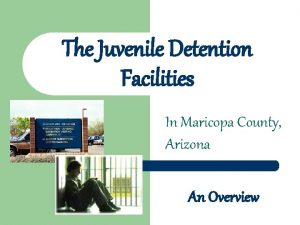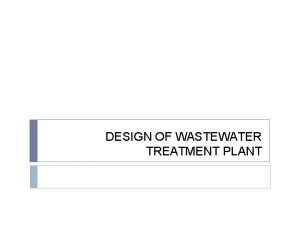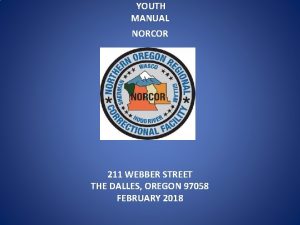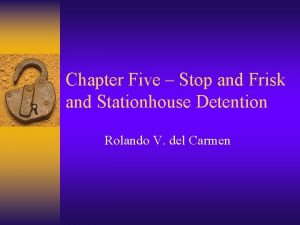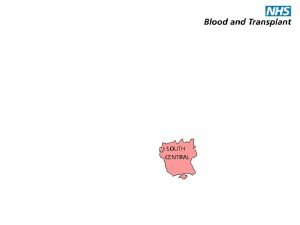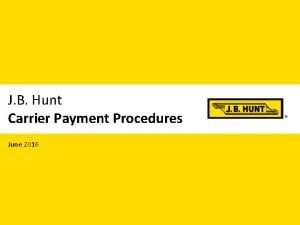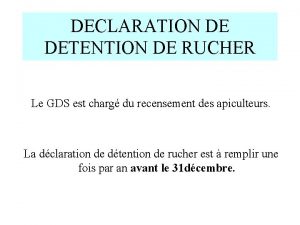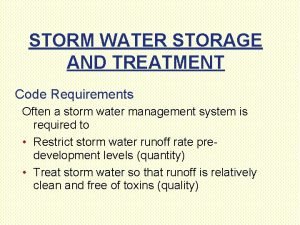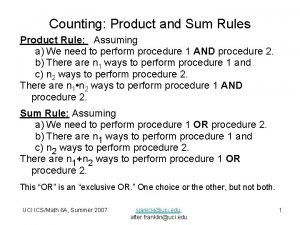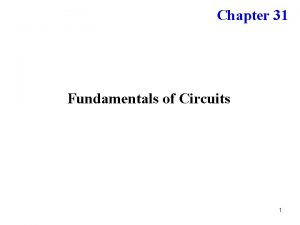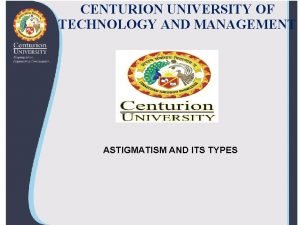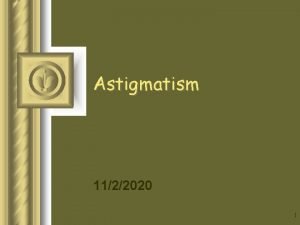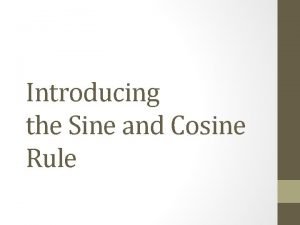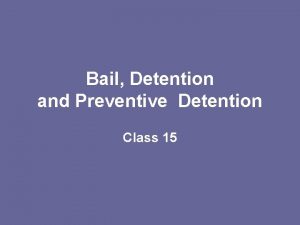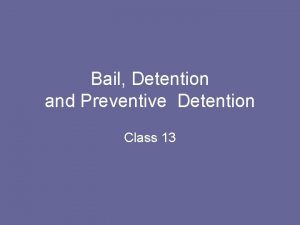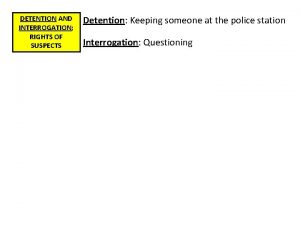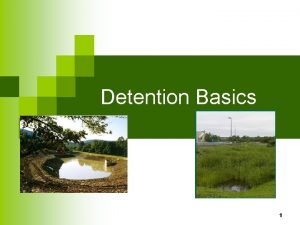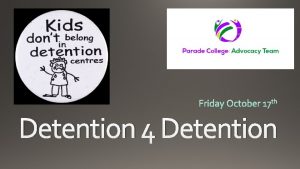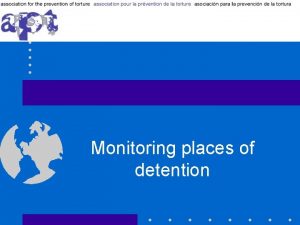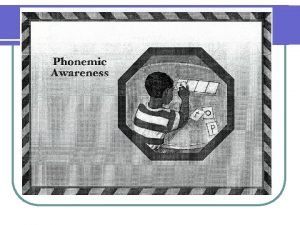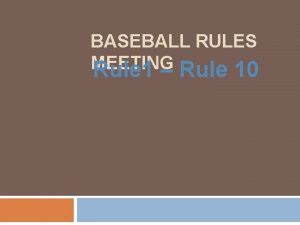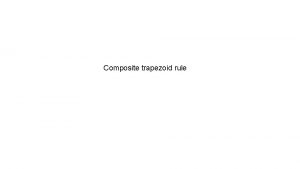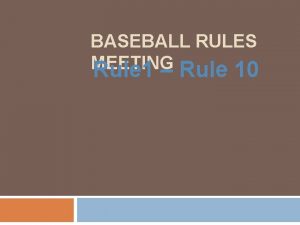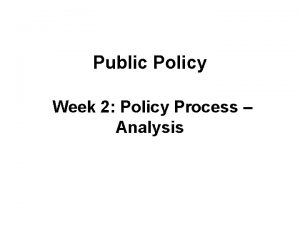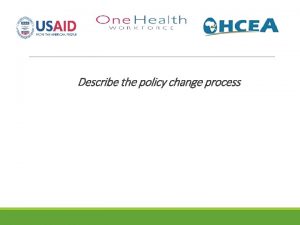Detention Rule 35 Policy and Process Awareness for






















- Slides: 22

Detention Rule 35 – Policy and Process Awareness for Medical Practitioners working in Immigration Removal Centres Training Package v 0. 1

DETENTION RULE 35 AIMS AND OBJECTIVES Aims • • To increase awareness of Rule 35 of the Detention Centre Rules. To guide Immigration Removal Centre medical practitioners on when and how to complete a Rule 35 report. Objectives • • Understand Rule 35, its importance, and the process it requires • Understand where to obtain further information about the policies and processes outlined. 2 Understand the role of Immigration Removal Centre medical practitioners in preparing and submitting a Rule 35 report.

DETENTION RULE 35 OVERVIEW OF KEY LEARNING POINTS • Rule 35 of the Detention Centre Rules is in place to ensure that concerns held by IRC medical practitioners (this means someone who has been trained and registered as a general practitioner) regarding health, suicide risks or histories of torture are raised and properly notified to UKBA caseworkers. • Cedars pre-departure accommodation is not covered by Detention Centre Rules but the spirit of R 35 and the processes to be followed should apply to those accommodated at Cedars. • On receipt of a Rule 35 report from an IRC medical practitioner, the UKBA caseworker will review the appropriateness of detention according to detention policy and respond to the issues raised. • A Detention Services Order (DSO) on Rule 35 explains the policy and process in greater detail. 3

DETENTION RULE 35 SECTION 1: WHAT IS RULE 35? • Rule 35’s purpose is to ensure that concerns held by Immigration Removal Centre medical practitioners about: 1) a detainee’s health being affected by continued detention; 2) a suspicion a detained person has suicidal intentions; 3) or a concern that a detained person may have been a victim of torture; are notified to UK Border Agency (UKBA) case owners without delay. • This training covers all 3 circumstances in which a medical practitioner may submit a Rule 35 report, although it concentrates on R 35 (3), i. e. reports regarding a concern a detained person may have been a victim of torture 4

DETENTION RULE 35 SECTION 1: WHY IS RULE 35 IMPORTANT? • Rule 35 of the Detention Centre Rules is intended to ensure that detainees who may be particularly vulnerable are identified and brought to the attention of UKBA. This enables UKBA to recognise them and to appropriately consider the suitability of their continued detention, in line with detention policy. • This is especially important if the medical practitioner is concerned that a detained person may have been a victim of torture because government policy is that - unless there are very exceptional circumstances - detention is not normally suitable for those with independent evidence of having been tortured. • A medical practitioner’s report may help the UKBA case owner assess whethere is independent evidence that the individual has been tortured. 5

DETENTION RULE 35 SECTION 2: OVERVIEW - RULE 35 PROCESS 6 • The IRC medical practitioner will complete a Rule 35 report whenever appropriate, update their local records and pass the report to the UKBA contact management team. • Upon receipt of the Rule 35 report, the UKBA team will identify and confirm the detainee’s named case owner, and allocate the report to that officer , confirming receipt. • The case owner then has until the end of the second full day after receipt to consider the report along with other evidence relating to the case, obtain approval for the approach to be taken from a senior case owner, undertake a full detention review, take any due action, and return a written response to the originating IRC • The IRC medical practitioner should review the response to check that their concerns have been addressed, and speak to the UKBA team if they have not.

DETENTION RULE 35 SECTION 3: REQUIREMENTS FROM MEDICAL PRACTITIONERS AND HEALTHCARE STAFF • Rule 35 reports should be prepared and submitted by medical practitioners only. • A medical practitioner must submit a Rule 35 report if they have any concerns which engage one or more of the criteria in Rule 35. • It is important that nurses and other healthcare professionals are aware that they should report to an IRC medical practitioner any concerns or claims they receive relating to ill health and suicide risks which might engage Rule 35(1) or (2), or relating to any detainee who claims to have been a victim of torture. • 7 An appointment should be made as quickly as possible for the detainee to see the IRC medical practitioner in order for an assessment to be made as to whether or not the medical practitioner has concerns that the detainee may have been the victim of torture.

DETENTION RULE 35 SECTION 4: PREPARING A RULE 35 REPORT • Rule 35 reports must be submitted on the Rule 35 form. • The form has 5 sections: 1. 2. 3. 4. 5. Detainee’s details Consent to disclose medical information Nature of concern Legal representative aware? Relevant clinical information • Once completed, a copy of the report must be submitted without delay to the UKBA Centre Manager. • A copy of the completed report must be placed on the detainee’s medical record and provided to the detainee free of charge. 8

DETENTION RULE 35 SECTION 4: PREPARING A RULE 35 REPORT Section 1: Detainee’s details First Name: Date of Birth: UKBA reference number: Length of time in detention: This section is self-explanatory. 9 Surname:

DETENTION RULE 35 SECTION 4: PREPARING A RULE 35 REPORT Section 2: Consent to disclose medical information I ………………………………. . hereby give my consent to the medical practitioner and/or healthcare staff releasing medical information to the UK Border Agency with regard to my illness or condition. I understand that the UK Border Agency will consider the information in relation to my continuing detention and asylum claim [if applicable in my case]. Signed: Name of detainee: Key points • The medical practitioner should ask detainees to give their consent to medical information being shared with UKBA. If the detainee refuses, the medical practitioner can still submit a Rule 35 report, but confidential medical information should not be included. • The detainee should not be asked to agree the content of the report. Consent is only sought to disclose medical information. Consent does not mean that the detainee agrees the report’s contents. 10

DETENTION RULE 35 SECTION 4: PREPARING A RULE 35 REPORT Section 3: Nature of report I hereby report in relation to the following section (please mark as appropriate) of Rule 35. Please tick all those that may be relevant, as some detainees may be affected by multiple issues. 1. 2. 3. This detainee’s health is likely to be injuriously affected by continued detention or any conditions of detention. I suspect this detainee may have suicidal intentions, and should be managed within the ACDT process. I have concerns that this detainee may have been the victim of torture. □ □ □ Key points • The medical practitioner should mark the appropriate box. • The medical practitioner may tick more than one box if the detainee is affected by multiple issues. 11

DETENTION RULE 35 SECTION 4: PREPARING A RULE 35 REPORT Section 4: Legal representative aware? As far as I know, the detainee’s legal representative is aware of this issue: - Yes - No Not known □ □ □ Key points • The medical practitioner should ask the detainee if their legal representative is aware of the issues raised. • The medical practitioner is not required to make the legal representative aware of the issues, nor to establish whether the legal representative is aware or not. 12

DETENTION RULE 35 SECTION 4: PREPARING A RULE 35 REPORT Section 5: Relevant clinical information • Please set out the clinical reasons leading to your conclusion at (1), (2) and/or (3) above. This should include relevant medical and psychiatric history; current concerns; and findings from a mental state and physical examination. Where relevant, a risk assessment of suicidal ideation/ intent should also be conducted. • Please ensure that a body map is completed and attached in cases involving scarring or other physical marks. Key points • We do not expect the report to contain the level of information found in a full Medico-Legal Report. However, a Rule 35 report will usually contain sufficient content to help the case owner when reviewing detention and responding to the report. • The medical practitioner should ensure their writing is clear and legible and uses easily understood language so that UKBA case owners can understand the significance of any evidence provided and are able to 13 make an informed decision when reviewing detention.

DETENTION RULE 35 SECTION 5: COMPLETING A RULE 35 (1) REPORT Rule 35(1) – “…health is likely to be injuriously affected by continued detention or any conditions of detention” In a Rule 35(1) case, the medical practitioner should be able to factually state the health consequences of ongoing detention and to recommend release for specified treatment. Key information is likely to be (this is not an exhaustive list): • • • 14 A description of the medical issues and clear summary of concerns. Factual description of the examination undertaken (e. g. date, in what language/using an interpreter, who was present, etc) The basis, with evidence, for the concern. Detail of treatment required and why the detainee’s health can not be managed by medical intervention in a detained setting. An estimate of the timescale for remedial action.

DETENTION RULE 35 SECTION 6: COMPLETING A RULE 35 (2) REPORT Rule 35(2) – “…having suicidal intentions” In a Rule 35(2) case, the medical practitioner should be able to state the health consequences of ongoing detention as a matter of clinical opinion, to address the treatment and healthcare management options in detained and non-detained environments, and where clinically appropriate, recommend release. The medical practitioner must also consult the procedures for managing detainees in accordance with Assessment Care in Detention and Teamwork (ACDT). If the medical practitioner believes a mental health assessment is required this should be completed, and the outcome of the assessment included in the Rule 35 report. Continued… 15

DETENTION RULE 35 SECTION 6: COMPLETING A RULE 35 (2) REPORT Rule 35(2) – “…having suicidal intentions” Key information is likely to be (this is not an exhaustive list): • • 16 The basis, with evidence, for the concern. Factual description of the examination undertaken (e. g. date, in what language/using an interpreter, who was present, etc) Details of any incidents of self harm and attempted suicide. Any known triggers/causes. Whethere are risks to others. The likely effect on their mental health of placing the detainee on ACDT The likely effect on their mental health of continued detention Detail of treatment required, to include whether the risk of suicide can be satisfactorily reduced through medication and/or appropriate counselling, and what arrangements would be required to manage the risk of suicide in a non-detained environment.

DETENTION RULE 35 SECTION 7: COMPLETING A RULE 35 (3) REPORT Rule 35(3) – “… concerned a detained person may have been the victim of torture. ” Rule 35(3) reports are just one of the three types of Rule 35 report, but are likely to be more commonly issued than the other types. • We understand that medical practitioners are not specially trained to assert the consistency of the evidence they find with the individual’s account of their torture. But the medical practitioner should be able to point to physical or mental symptoms which have led them to be concerned, in a professional capacity, that the individual is a victim of torture. • It is not necessary that these concerns be definitive. But a medical practitioner should not complete a report simply on the basis that the individual has told them they are a victim of torture. 17

DETENTION RULE 35 SECTION 7: COMPLETING A RULE 35 (3) REPORT • There are organisations whose clinicians are specially trained to conduct the delicate work of examining scars and injuries and assert the consistency of the evidence they find with the individual’s account of their torture. One such organisation is Freedom from Torture (Ff. T) a charity who work with survivors of torture. • Ff. T’s medical practitioners apply international guidelines set out in the Istanbul Protocol for the assessment of persons who allege torture. They document evidence of the effects of torture through a Medico. Legal Report (MLR) and submit this to the Home Office to support an asylum claim, or at an appeal. • Rule 35 reports will not contain the level of information found in a Medico-Legal Report as an IRC medical practitioner will not be an expert on torture recognition. However, medical practitioners should be alert to the possibility of torture, and a Rule 35 report will usually contain sufficient content to help the case owner review detention and respond to the report. 18

DETENTION RULE 35 SECTION 7: COMPLETING A RULE 35 (3) REPORT • To help the medical practitioner, he/she may find it helpful to refer to the definition of torture from the UN Convention Against Torture, Inhuman and Degrading Treatment or Punishment, 1984: 19 “Torture means - any act by which severe pain or suffering, whether physical or mental, is intentionally inflicted on a person - for such purposes as obtaining from him or a third person information or a confession, punishing him for an act he or a third person, has committed or is suspected of having committed, or intimidating or coercing him or a third person, or for any reason based on discrimination of any kind, - when such pain or suffering is inflicted by or at the instigation of or with the consent or acquiescence of a public official or other person acting in an official capacity. It does not include pain or suffering arising only from, inherent in or incidental to lawful sanctions. ”

DETENTION RULE 35 SECTION 7: COMPLETING A RULE 35 (3) REPORT A Rule 35 (3) report will be most useful to reviewing detention decisions if the medical practitioner does the following: • Describe the examination undertaken (e. g. date, in what language/using an interpreter, who was present, etc) • Ask to see any scars and record what he/she sees, including on a body map if relevant. • Ask detainees about and record: - When the torture allegedly took place; - How the injuries/mental health issues arose; - How the torture is currently affecting them. • Assess whether it is in his/her view medically possible or plausible with the attribution claimed by the detainee. 20

DETENTION RULE 35 SECTION 7: COMPLETING A RULE 35 (3) REPORT Continued… • Record any mental or physical health problems that are relevant to the torture allegation. • Medical practitioners should be able to indicate why they consider that the account is medically possible or plausible. • Where the medical practitioner concludes his/her examination with a concern that torture evidence is possible or plausible, but nonetheless can identify medical evidence which may be contrary to the account given by the detained person or where the injury/symptom giving rise to the concern may have other possible or plausible explanations, he/she must disclose that evidence. • Medical practitioners are not expected to apply probability levels or assess relative likelihoods of different causes. 21

DETENTION RULE 35 SECTION 8: UKBA RESPOND • A copy of the UKBA response must be sent to the medical practitioner, who should sign the report to confirm he/she has received the outcome. • A copy should then be placed on the detainee’s medical record. • If the medical practitioner is concerned that their concerns, as outlined in the Rule 35 report, have not been properly addressed in the case owner’s response, they should escalate through the UKBA Centre Management chain. • The medical practitioner should fully expect their key concerns to be addressed in the case owner’s response and they should speak to the UKBA centre team where this has not happened. The medical practitioner should however note that factors other than the medical information may in some cases also influence the conclusion of the Rule 35 consideration, and so should not have an expectation of the 22 case having a particular outcome.
 Cvs privacy awareness and hipaa training answers
Cvs privacy awareness and hipaa training answers Cjis security awareness training
Cjis security awareness training Detention slips
Detention slips Maricopa juvenile detention center
Maricopa juvenile detention center Rectangular clarifier design
Rectangular clarifier design Norcor clothing
Norcor clothing Stationhouse detention
Stationhouse detention Trish collins cei
Trish collins cei Landstar invoice submission
Landstar invoice submission Seminole county juvenile detention center
Seminole county juvenile detention center Déclaration de détention de ruches
Déclaration de détention de ruches Retention vs detention pond
Retention vs detention pond Coefficient of detention
Coefficient of detention Ammonia awareness safety policy
Ammonia awareness safety policy When to use sine rule or cosine rule
When to use sine rule or cosine rule Sohcahtoa practice
Sohcahtoa practice Kirchhoff's junction rule
Kirchhoff's junction rule Product sum rule
Product sum rule Kirchhoff loop rule
Kirchhoff loop rule Against the rule astigmatism
Against the rule astigmatism With the-rule astigmatism examples
With the-rule astigmatism examples With the rule astigmatism axis
With the rule astigmatism axis Sine rule cosine rule
Sine rule cosine rule



